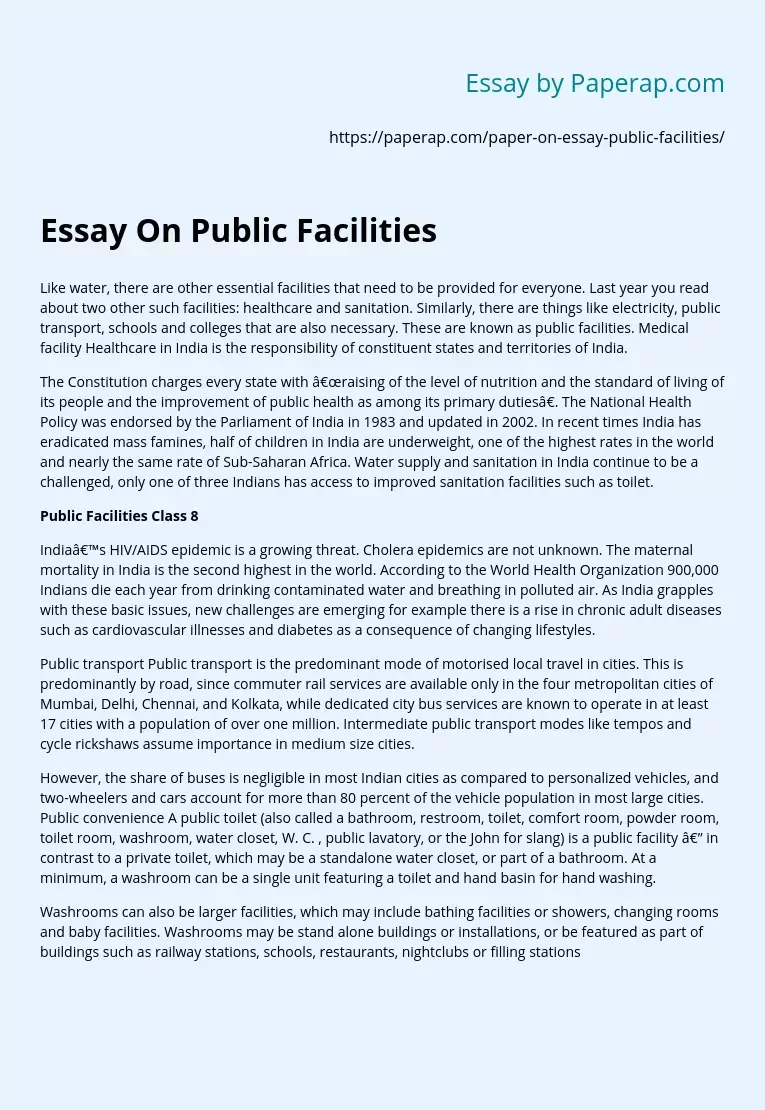Essay On Public Facilities
Like water, there are other essential facilities that need to be provided for everyone. Last year you read about two other such facilities: healthcare and sanitation. Similarly, there are things like electricity, public transport, schools and colleges that are also necessary. These are known as public facilities. Medical facility Healthcare in India is the responsibility of constituent states and territories of India.
The Constitution charges every state with “raising of the level of nutrition and the standard of living of its people and the improvement of public health as among its primary duties”.
The National Health Policy was endorsed by the Parliament of India in 1983 and updated in 2002. In recent times India has eradicated mass famines, half of children in India are underweight, one of the highest rates in the world and nearly the same rate of Sub-Saharan Africa. Water supply and sanitation in India continue to be a challenged, only one of three Indians has access to improved sanitation facilities such as toilet.
Public Facilities Class 8
India’s HIV/AIDS epidemic is a growing threat. Cholera epidemics are not unknown. The maternal mortality in India is the second highest in the world. According to the World Health Organization 900,000 Indians die each year from drinking contaminated water and breathing in polluted air. As India grapples with these basic issues, new challenges are emerging for example there is a rise in chronic adult diseases such as cardiovascular illnesses and diabetes as a consequence of changing lifestyles.
Public transport Public transport is the predominant mode of motorised local travel in cities.
This is predominantly by road, since commuter rail services are available only in the four metropolitan cities of Mumbai, Delhi, Chennai, and Kolkata, while dedicated city bus services are known to operate in at least 17 cities with a population of over one million. Intermediate public transport modes like tempos and cycle rickshaws assume importance in medium size cities.
However, the share of buses is negligible in most Indian cities as compared to personalized vehicles, and two-wheelers and cars account for more than 80 percent of the vehicle population in most large cities. Public convenience A public toilet (also called a bathroom, restroom, toilet, comfort room, powder room, toilet room, washroom, water closet, W. C. , public lavatory, or the John for slang) is a public facility — in contrast to a private toilet, which may be a standalone water closet, or part of a bathroom. At a minimum, a washroom can be a single unit featuring a toilet and hand basin for hand washing.
Washrooms can also be larger facilities, which may include bathing facilities or showers, changing rooms and baby facilities. Washrooms may be stand alone buildings or installations, or be featured as part of buildings such as railway stations, schools, restaurants, nightclubs or filling stations. It can also be found on some public transport vehicles, for use by passengers. They are usually fixed facilities, but can also refer to smaller public portable toilets, or larger public portable washrooms constructed as portable buildings.
Essay On Public Facilities. (2019, Dec 05). Retrieved from https://paperap.com/paper-on-essay-public-facilities/

